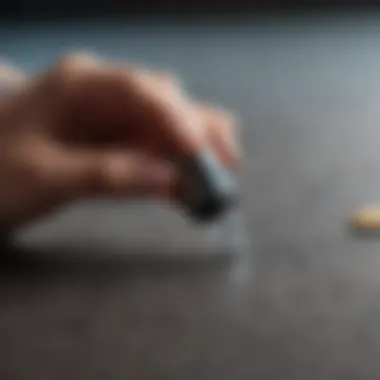Effective Methods for Removing Acrylic Nails at Home


Intro
Removing acrylic nails at home can seem daunting, yet it is a skill that many can master with proper guidance. Understanding the methods available is crucial to preserve the health of your natural nails and prevent damage. This article aims to provide you with comprehensive techniques, safety considerations, and aftercare tips to help you confidently undertake the process.
The removal of acrylic nails is not merely about getting rid of the artificial enhancements. It involves planning and care to ensure that your nails remain healthy and vibrant. Many women of all ages have come to rely on acrylic nails for various reasons, including style and durability. However, improper removal can lead to nail damage, breakage, or lingering acetone odor. Therefore, it is vital to approach this task with knowledge and caution.
Prelude to Acrylic Nails Removal
Understanding Acrylic Nails
Acrylic nails are artificial enhancements made from a combination of acrylic powder and liquid monomer. When applied correctly, they bond to the natural nail and create a durable shell. This can help those with weak or brittle nails achieve a desired length and strength. Despite their many advantages, they can pose risks if not properly removed, leading to weak or damaged natural nails.
The makeup of acrylic nails can cause them to adhere firmly to the natural nail, which can be beneficial in terms of wear but challenging during removal. A clear comprehension of what acrylic nails are will aid in the removal process. Knowing their composition informs the choice of methods that can be employed safely and effectively.
The Importance of Safe Removal
Taking the time to safely remove acrylic nails is essential for preserving the health of natural nails. An incorrect removal method can compromise nail structure, leading to split, brittle, or even infected nails. Safe practices promote longevity and well-being of the natural nails after acrylics.
Utilizing suitable techniques, such as soaking in acetone or using filing methods, will play a crucial role in this process. These methods often help dissolve the acrylic without requiring excessive force that could harm the underlying nail. Furthermore, taking care to avoid common mistakes, such as using non-acetone solvents or rushing through the removal, is crucial.
"Proper care and attentiveness during acrylic nail removal can prevent damaging your natural nails, ensuring they remain healthy and strong."
Preparing for the Removal Process
Preparing for the removal of acrylic nails is a crucial step in ensuring a safe and effective experience. Proper preparation can help you avoid unnecessary damage to your natural nails and make the overall process smoother. Taking the time to gather the right tools and create a suitable environment will contribute significantly to the success of the removal. When you take these initial steps, you will be better equipped to handle any challenges that might arise during the process.
Gathering Necessary Tools and Supplies
Before starting the removal process, it is essential to have all necessary tools and supplies ready. This will save you time and minimize interruptions during the procedure. Here are the main items you will need:
Acetone
Acetone is a key ingredient in the removal of acrylic nails. Its effectiveness lies in its ability to break down the acrylic material, allowing for easier removal. One essential characteristic of acetone is its strong solvent properties. This makes it a popular choice for many at-home nail enthusiasts. While acetone is generally seen as beneficial, it can also be quite drying to the skin and natural nails. Therefore, it is important to follow up with moisturizing products after using acetone during the removal process.
Nail Clippers
Nail clippers serve an important role in the preparation for acrylic nail removal. Their primary function is to trim excess length from the acrylic nails before beginning the soaking or filing process. This helps to make the removal process more manageable and minimizes the amount of material that needs to be dissolved. Nail clippers are widely regarded as a beneficial tool for this task. However, one must be careful not to cut too close to the natural nail bed, as this can lead to discomfort or injury.
Nail File
A nail file is another helpful tool when it comes to removing acrylic nails. Before soaking, using a nail file to gently buff the surface of the acrylic can expedite the process. A key feature of nail files is their versatility; they come in different grits, allowing for varying levels of abrasiveness. This feature can be advantageous when aiming to remove the shiny top coat of the acrylic, as it helps the acetone penetrate more effectively. However, over-filing can harm the natural nail. Therefore, caution is advised during this step.
Creating a Suitable Environment
The atmosphere in which you choose to remove your acrylic nails can greatly impact the effectiveness of the process. A suitable environment will allow you to focus and ensure that you have everything within reach.


Lighting
Good lighting is essential for effectively removing acrylic nails. Bright light allows you to see what you are doing clearly, helping you avoid mistakes and ensuring an efficient removal process. Having adequate illumination means you can better assess the condition of your nails throughout the procedure. Poor lighting can lead to errors, leading to longer removal times and potential accidents. Therefore, opt for a well-lit space for your nail removal task.
Comfort
Paying attention to comfort is an often-overlooked aspect of the removal process. Sitting in a comfortable position will help you maintain concentration and avoid unnecessary distractions. Consider using a cushioned chair or a designated table where you can comfortably work at your own pace. A relaxed environment not only enhances the experience but also can lead to a more thorough and careful removal process. Avoid rushing through it; take your time to ensure proper care for your nails.
Soaking Method for Removal
The soaking method is recognized as one of the most effective ways to remove acrylic nails at home. This technique revolves around using acetone, a solvent that effectively breaks down the acrylic material. A significant benefit of this method is its ability to remove the nails without causing excessive trauma to the natural nail underneath. It provides a more controlled and less aggressive approach compared to other removal techniques that can risk damaging the nail bed.
Step-by-Step Guide
Preparing Acetone Bath
Preparing an acetone bath is a crucial first step in the soaking process. This involves filling a suitable bowl with pure acetone. The key characteristic of using acetone is its potency; it is capable of swiftly dissolving acrylic nails while being less harmful than other alternatives. When preparing this bath, it is important to ensure that the acetone is at room temperature. Cold acetone may slow down the removal process, which can lead to extended soaking times and potential irritation.
The acetone bath method is beneficial because it fosters an effective environment for the acrylic to break down. However, a consideration to keep in mind is that acetone can be drying to the skin and nails, so taking precautions, such as using barrier creams or gloves, can help mitigate this issue.
Soaking Duration
Soaking duration is another vital factor in this method. Typically, acrylic nails should be soaked in acetone for approximately 20 to 30 minutes, depending on the thickness of the acrylic used. A key characteristic here is timing; soaking for too short a time may not allow the acrylic to fully dissolve, whereas excessively long soaking can lead to nail bed damage or over-drying of the surrounding skin.
During this time, it is advisable to check periodically how much of the acrylic has softened, allowing for a tailored approach based on progress. The unique feature of monitoring soaking duration is that it ensures a balance between effectiveness and safety, optimizing results while minimizing potential damage to the natural nail.
Tips for Effectiveness
Using Foil Wrap
Using foil wrap with the acetone-soaked cotton balls is an effective tactic in enhancing the soaking method. When the cotton balls are placed on each nail and wrapped in foil, it helps to trap heat, which increases the effectiveness of acetone. This method is popular because it significantly accelerates the breakdown of acrylic.
A unique feature of foil wrapping is that it keeps the acetone concentrated against the acrylic, which can lead to quicker and easier removal. However, users should ensure that the foil is snug but not so tight that it causes discomfort or cuts off circulation.
Avoiding Over-Soaking
Avoiding over-soaking is an essential consideration to protect both the skin and nails. Prolonged exposure to acetone can lead to adverse effects, such as brittleness or peeling of the natural nail. The key characteristic of this caution is awareness; it is vital to monitor the time spent soaking carefully. This method also emphasizes the importance of checking the nails periodically to avoid damage.
The unique aspect of understanding the risks of over-soaking puts nail health at the forefront of the removal process. While acetone is an effective solvent, users should adopt a balanced approach by following recommended soaking times closely to minimize harm.
Filing Method of Acrylic Nail Removal
The filing method for removing acrylic nails is a practical and often preferred technique for many, primarily due to its non-invasive nature. Unlike soaking, which relies heavily on chemical solutions, filing involves the physical reduction of the acrylic material. This method is essential for controlling the removal pace and reducing the risk of damage to the natural nail underneath. It provides greater awareness of the state of both acrylic and natural nails throughout the process, allowing for adjustments as needed.
How to File Down Acrylics
To effectively file down acrylic nails, start by gathering the appropriate tools. You will need a coarse nail file, preferably one with a grit of 100 to 180. Begin by trimming the length of the acrylic nails using nail clippers. This reduces the bulk and makes the filing process easier. Then, hold the file at a slight angle and begin to gently file the surface of the acrylic. Work in a back-and-forth motion, applying light pressure to avoid unnecessary strain on the natural nail below. Repeat this until the acrylic is significantly thinner, making it easier to remove.


Continuous monitoring is crucial. Periodically check for the appearance of your natural nail. When you start seeing a shift in color or texture, it is a signal that you are getting close to the nail beneath. Do not rush; filing patiently prevents damage and ensures a cleaner removal.
Safety Measures While Filing
Avoiding Natural Nail Damage
Avoiding damage to the natural nail is paramount when using the filing method. The integrity of your nails affects their overall health and appearance. A key characteristic of this approach is that it allows for a more gradual reduction of acrylic. This time-consuming aspect provides a distinct advantage over techniques that may be abrasive or hasty.
The unique feature of avoiding natural nail damage is the emphasis on gentle pressure. Over-filing or aggressively using a low-quality file can lead to thinning or splitting of the natural nails, which is not desirable. Taking care to ensure that the natural nail is only filed lightly while still focusing on the acrylic keeps the process efficient yet protective.
Using the Right File
Selecting the right file is essential in the filing method. A fine file or buffer can polish acrylic but does not replace the need for a coarser file to effectively remove material. The characteristic of finding the correct file type contributes to a successful removal process by ensuring that the acrylic is addressed appropriately without being overly harsh.
The unique aspect of using the right file is the careful balance it provides. A file that is too coarse can lead to excessive wear on the natural nail, while one that is too fine might not effectively remove the acrylic. Striking this balance enhances the entire removal experience, ensuring results that are both clean and safe. By choosing the right tools, you promote a healthier overall state for your nails post-removal.
Alternative Removal Techniques
The topic of Alternative Removal Techniques is significant in the context of removing acrylic nails at home. While traditional methods, like soaking in acetone, have their advantages, alternative techniques offer unique benefits. They provide options that may be less harsh on the natural nail and improve the overall experience of removal. Knowing these methods can help individuals make informed decisions, especially if they are looking to minimize damage to their nails or prefer a less chemical-intensive approach. These alternatives can both enhance safety and comfort during the removal process.
Using Dental Floss for Removal
One innovative method for removing acrylic nails involves using dental floss. This technique is particularly useful when the acrylic nails are lifting at the edges. Starting with clean hands, the process begins by gently inserting a piece of dental floss between the acrylic and the natural nail.
- Technique: With a slight sawing motion, the dental floss can help pry off the acrylic without needing excessive force.
- Effectiveness: This method allows for more control over the removal process, significantly lowering the risk of damaging the nail bed or causing pain.
- Considerations: Ensure that the dental floss is not too thick, as this could make removal more difficult. Always start from the edge and work your way inwards. This method is not suitable for all types of acrylic applications, especially if the acrylic is firmly adhered.
Applying Heat for Ease of Removal
Heat can be another effective means for removing acrylic nails. The application of warmth helps in softening the acrylic, making it easier to remove without extensive filing or soaking.
- Method: One of the simplest ways to apply heat is by soaking fingers in warm water. Make sure that the water is not too hot to avoid burns.
- Additional Techniques: A heating pad or warm towel can also be applied around the nails to achieve the same effect. Ensure that the heat is comfortable while allowing the acrylic to loosen.
- Benefits: This method can provide a more pleasant experience than harsh chemicals. It minimizes the time needed to soak acrylics off while also ensuring the integrity of the natural nail.
- Safety Tip: Monitor the temperature to prevent burns. After applying heat, use caution when attempting to remove the acrylic as the material will be softer.
Important Note: Combining these methods can further enhance effectiveness. For example, using dental floss after applying heat can create a more efficient removal process.
Post-Removal Nail Care
Taking care of your nails after acrylic removal is crucial for maintaining their strength and overall health. Proper post-removal care can help in reducing the damage caused and promote a smoother recovery for your natural nails. This section discusses effective practices you can implement to ensure your nails do not suffer long-term consequences from the removal process.
Moisturizing the Natural Nail
Moisturizing is a vital step post-acrylic removal. It aids in regenerating the natural nail plate and surrounding skin, which may have been dehydrated during the acrylic application and removal processes.
Using Cuticle Oil
Using cuticle oil can be quite beneficial. Cuticle oil helps in nourishing the cuticles and skin around the nails, promoting healthier growth. Its key characteristic is its ability to penetrate deeply, providing hydration where it is needed. This oil often consists of ingredients like jojoba oil or vitamin E, both known for their moisturizing properties. The unique feature of cuticle oil is that it can easily be applied at home without requiring special tools or routine. A potential downside is that, for some, the oil may feel greasy or heavy, so it’s important to find a formulation that suits your preferences.
Hydrating Creams


In addition to cuticle oil, hydrating creams are another excellent option. They provide moisture to the skin surrounding the nails while also offering a protective barrier against environmental factors. Hydrating creams usually contain ingredients like aloe vera or shea butter, which are also known for their soothing properties. They are popular because they can be used multiple times throughout the day, making it easy to incorporate into your daily routine. However, one unique challenge can be the absorption rate. Some creams may take longer to dry, which may not be ideal for some users, especially if one needs to use hands soon after application.
Monitoring Nail Health
Once the acrylics are removed, monitoring the condition of your nails is essential to catch any potential damage early. This proactive approach can prevent further issues and encourages healthier nails moving forward.
Identifying Damage
Identifying damage after removal allows you to assess the current state of your nails. There are several signs to look for, such as thinning, splitting, or unusual discoloration. Recognizing these problems early can enable you to take immediate corrective measures. The key characteristic of this practice is its proactive nature, allowing you to intervene before the condition worsens. However, a downside can be that some individuals may overlook minor signs or may not have knowledge of what constitutes typical nail health.
Promoting Recovery
Promoting recovery involves establishing habits that support the natural nail's regrowth and resilience. This can include a balanced diet rich in vitamins and minerals that foster nail health, as well as regular use of moisturizing products. The key characteristic here is the holistic approach to caring for nails, considering both external and internal factors. One benefit of focusing on recovery is that it encourages patience and self-care, which can lead to long-term health improvements. A potential drawback is that recovery may take time, which can be frustrating for those used to maintaining long acrylics.
By engaging in proper post-removal nail care, you enhance the recovery process of your natural nails and ensure they remain strong and beautiful.
Common Mistakes to Avoid
Removing acrylic nails is a sensitive process. While achieving a clean finish is important, numerous mistakes can hinder the effectiveness and safety of this task. Avoiding these errors can protect the natural nail, ensuring that it remains healthy. Understanding these common pitfalls is crucial for anyone considering the removal process.
Using Non-Acetone Products
Many individuals might consider using non-acetone nail polish removers as an alternative for acrylic nail removal. However, this choice can lead to complications. Non-acetone products lack the strength needed to dissolve acrylic effectively. They often contain ingredients that might not penetrate the acrylic material itself. As a result, users can end up scrubbing harder than necessary, which could lead to damage. This compromises the integrity of the natural nail beneath.
Tip: Always use acetone-based removers when dealing with acrylic nails. They not only expedite the removal process but also minimize the risk of significant damage to the nail bed.
Rushing the Process
In the realm of acrylic nail removal, patience is indeed a virtue. Rushing through the process can lead to disastrous results. Whether it’s skimping on soaking time or hastily filing down the acrylic, these actions can lead to unnecessary trauma to the natural nail.
When users attempt to pull off the acrylic too early, they might find that they are inadvertently peeling away parts of their natural nail. This can cause long-term damage, weakening the nail over time. Always prioritize a careful approach. Each method—be it soaking or filing—requires adequate time to be effective.
- Allow sufficient soaking time: The acetone needs to work effectively to break down the acrylic.
- Take breaks during filing: If you are filing, feel free to stop and check your progress to avoid excessive pressure on the nail.
The End
The process of removing acrylic nails at home is not just a simple task; it involves various considerations and best practices that can directly impact nail health. This article has covered several effective methods, each with unique advantages and specific safety measures to consider. By educating yourself on these techniques, you increase your ability to manage your nails responsibly, ensuring both convenience and care.
Recap of Effective Methods
To summarize our discussion:
- Soaking Method: Using acetone to soak the nails is widely practiced. It efficiently breaks down the acrylic material, allowing for easier removal.
- Filing Method: For those less inclined to use acetone, filing presents an option. However, it requires careful application to avoid damaging the natural nail beneath.
- Alternative Techniques: Utilizing dental floss or applying heat, such as warm towels, are creative approaches for those seeking a less traditional method.
Understanding these options gives you the insight needed to choose the method that best fits your situation. Consider factors such as the condition of your nails and the time you have available.
Encouragement for Careful Practices
Taking your time during the acrylic removal process cannot be overstated. Rushing may lead to mistakes and injury, which could negate the benefits of a DIY approach. Always prioritize the health of your natural nails.
- Follow recommended soaking times to prevent overexposure.
- Keep your nails moisturized post-removal to support recovery.
Adhering to these principles not only facilitates a smoother removel process but also enhances the durability of your natural nails for the future. Treat your nails with respect, and they will serve you well.



